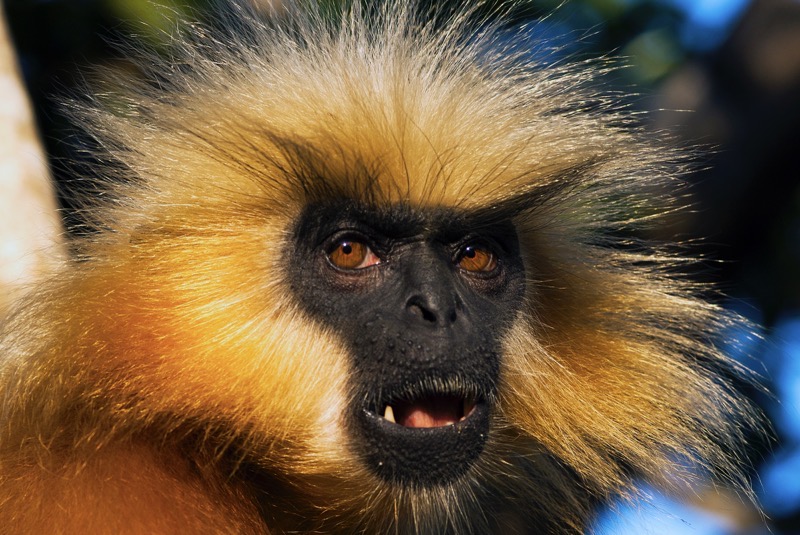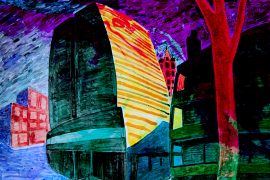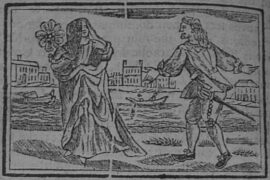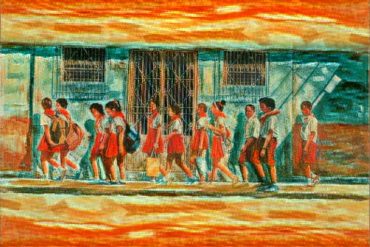When you see langurs at temples in India, you’re often cautioned not to feed them. People warn of their violent behaviour. However, have you ever noticed that these black-faced primates are usually peaceful, just hanging out, sometimes carrying a baby clinging to the body of the female?
India is home to 26 primate species. Northeast India, a biodiversity hotspot, has 12 of those species. As the region witnessed rapid infrastructural development, monkey populations got pushed into the margins.
In 2020, Gobinda, the last golden langur at the Umananda Temple in Peacock Island, passed away; one of the world’s most endangered primates vanished from yet another location. The golden langurs were unknowingly introduced 36 years ago to this region near the Brahmaputra.
The Gee’s golden langurs, only found in Bhutan and India, are quickly disappearing off the face of the planet. Only 7,000 creatures survive in the wild today in a sliver of woodland in western Assam, with 80 per cent of the population living outside protected areas.
Gee’s golden langurs (Trachypithecus geei) were formerly found in vast woodland swathes, appearing rich cream-coloured in low light and brilliant golden when the sun rays hit their coat.
Golden langurs are mostly leaf eaters, but they also consume fruits, flowers, seeds, twigs, and other plant components from over 200 plant species.
The population is divided into many isolated groups clinging to fragmented woodland areas and peripheral settlements, often clashing with locals. The animals spend 99 per cent of their time on trees, moving an average of 200 to 700 metres each day to take advantage of forest canopies, occupying what remains of the lowland evergreen, semi-evergreen, and riparian wet deciduous, and sal-dominated primary forests.
Their long-term survival depends on the genetic exchange, but the golden langur population is scattered and in danger of becoming inbred, according to primatologist Jihosuo Biswas.
Recent research also discovered a shift in the birth cycle. Genetic stochasticity, caused by small population sizes, exacerbates population extinction. It is amplified mainly due to the fragmentation of their numbers disrupting the gene flow. Because of stochasticity, a smaller population may result in individuals with lower genetic quality.
“Irrespective of how small the populations are, they are all crucial to the long-term survival of the species,” said Biswas in an interview with Mongabay-India. He advocates for a coordinated effort to manage tiny isolated populations to interbreed with other populations and reduce genetic and demographic stochasticity.
Conservationists and primatologists build on past achievements of catalysing public involvement. They are banking on legislative protection for the golden langur’s habitat and scaling up community-led conservation in Assam to boost the number of langurs.
The golden langur is protected under Schedule I of the Indian Wildlife (Protection) Act, 1972, Bhutan’s Forest and Nature Conservation Act, 1995, and is listed in the IUCN Red List of Threatened Species and Appendix I of CITES. However, the golden langur is considered more secure in Bhutan, with nearly half its habitat falling within three protected areas. In India, they reside in scattered communities in the forest patches that do not fit together like jigsaw pieces.
The species in India (Assam) cover 2,500 square kilometres to the north of the banks of Brahmaputra. The Manas Biosphere Reserve, a wooded region in western Assam near the Bhutan border in the Himalayan foothills, is home to most of Assam’s golden langurs.
Some populations are also in isolated woods of the Chakrashila Wildlife Sanctuary (WLS), Kakoijana Reserve Forest (RF), and nine other patches south of the Manas Biosphere Reserve. ‘Except for Chakrashila, which is a protected area and legally protected, all other fragments are reserve forests or proposed reserved forests and have very limited legal protection, including RFs in the western buffer areas of Manas Tiger Reserve,’ said Biswas.
The forests have little primary forest cover (0-10%), mainly covered by secondary forest, scrub, or open areas with no forest cover. Biswas explains that during the dry season, these forests do not provide the demand for food. The langurs are forced to seek sustenance in nearby settlements, resulting in human-monkey conflict and animal death.
Political instability and ethnic disputes in western Assam, which started in the 1980s, are related to the decrease in population and habitat; roadkills, electrocution by low-slung live wires, occasional poaching, and dog attacks now threaten the monkeys.
In June 2020, primatologists discovered that the Gee’s golden langur had faced forced abortion and infanticide. They had stillbirth of infants within the womb of females due to electrocution. One of the earliest instances of abortion due to the electrocution of a female occurred at Nayekgaon near Kokrajhar, some 225 kilometres west of Guwahati, on June 5, 2020, which happens to be the World Environment Day.
Golden langurs have been classified as one of the world’s top 25 most endangered primate species since 2016 by the IUCN report Primates in Peril. Despite many conservation efforts, environmentalists worry that each of the main risks to golden langurs is growing and is expected to deteriorate significantly in the future years.
‘In northeast India, if we do not involve the community, then it doesn’t work,’ said Kumara Honnavalli, a primatologist from the Salim Ali Centre for Ornithology and Natural History in Coimbatore. All protected areas in northeast India need the backing of the local community since community activities outnumber those of protected area administrators.
Although golden langurs have piqued the public’s and legislators’ interest, they are eclipsed by other highlighted species like the tiger and elephant. More studies are clearly and urgently needed to document the spatial and temporal population changes in decreasing forest areas.
-30-
Copyright©Madras Courier, All Rights Reserved. You may share using our article tools. Please don't cut articles from madrascourier.com and redistribute by email, post to the web, mobile phone or social media.Please send in your feed back and comments to [email protected]











